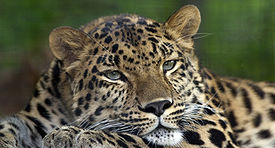 Russian Prime Minister Vladimir Putin has signed the decree which will put into effect a long-sought protected area, home to half of all remaining Far-Eastern leopards.
Russian Prime Minister Vladimir Putin has signed the decree which will put into effect a long-sought protected area, home to half of all remaining Far-Eastern leopards.
The leopard, also known as the Amur leopard, the only species in the world able to survive long cold periods, is on the brink of extinction with only about thirty surviving members. However, this decree will bring a more concerted protection effort to those already in place.
The new reserve will join two small protected areas into one, called Leopardovy Zakaznik (Leopard nature sanctuary), and will be managed by the Ministry of Nature Resources of Russia. According to the order, the ministry will also manage neighbouring Kedrovaya Pad nature reserve.
Before the decree, all three protected areas had been managed by different state agencies whose differing mandates meant that a unified Leopard conservation strategy was not in place. The transfer of jurisdiction to a single authoritiy will allow for a single strategy that places the restoration of the leopard population at the heart of its operations in the area.
The World Wildlife Fund proposed this change as early as 1999, in its Strategy for conservation of the Far Eastern leopard in Russia. “We are happy that finally, after all these years, the government has addressed this issue”, says WWF-Russia CEO Igor Chestin. “We hope that the Ministry will immediately start improving management of the protected area to ensure effective leopard conservation.” Particular attention will be placed on reducing threats from logging, forest fires, poaching and unregulated tourism.
To ensure Far-Eastern leopard protection, WWF created anti-poaching groups in the region. WWF also cooperates with Chinese conservation agencies to create a trans-border system of protected areas that sought to save the leopards habitat from industrial pollution. Education programs to inform locals of the threats facing this extremely rare cat species were set up, while customs agents were trained to track poachers who illegally sell leopard parts to China.
In 2007, WWF built a visit centre for the future protected area, which now will finally be given to the Leopardovy zakaznik, and will hope to create revenue that can go towards making the sanctuary commercially viable.
(Source: WWF)



















